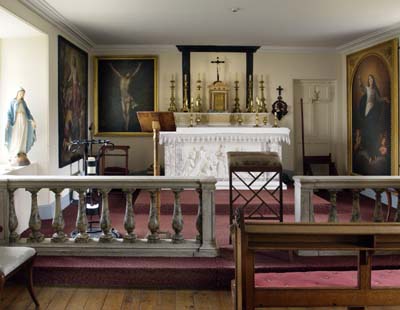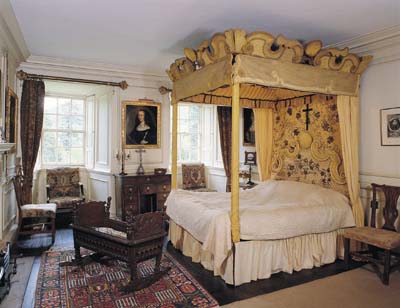
Lady Ann Seton, Countess of Traquair
Traquair House was originally a castle owned by the kings of Scotland. It later became the home of the Earls of Traquair and is still lived in by their descendants. John, the Third Earl, was fined 5000 Pounds (a large fortune in those days) for marrying a Catholic; the daughter of the Marquis of Huntly. When she died he married her sister-in-law, Lady Anne Seton. From her influence was established the tradition of Catholicism which remains in the family. During this time of religious conflict Mass had to be celebrated in secret. In the private Chapel at Traquair, Lady Ann Seton ordered a hidden escape to be made for the priests in case the house was searched by the suspicious authorities.
The Chapel at Traquair House

In 1628 Sir John Stuart was raised to the peerage, under the title of Lord Stuart of Traquair, and in 1633 was further honoured with the dignity of Earl of Traquair, Lord Linton and Caberston. At one time Lord High Treasurer of Scotland, and Lord High Commissioner of the General Assembly of the Church, he sank, towards the close of his life, to a state of destitution. In the former capacity he played a very prominent part in carrying out the commands of Charles I. regarding the introduction of the liturgy into Scotland, and in the latter presided over the Assembly of 12 August 1639, which ratified the Scottish Covenant. As comissioner, he opened parliament after the assembly, but owing to the incompatibility of its demands with the royal orders, he was obliged to prorogue it. Soon after he was impeached by Parliament as a grand incendiary, and only escaped capital punishment through the efforts of the king. His treasurership was taken from him, and he received a pardon on condition that he did not approach the royal person. His breaking through this condition led to further penalties and his banishment to Scotland. Restored to parliament in 1647, again through the King's intercession, he, in 1648, was taken prisoner at the battle of Preston, fighting for the royal cause. He was confined in Warwick Castle for four years, and his estate, considerably drawn upon, was meantime sequestrated. He died in 1659, after living some years in great obscurity and abject poverty. A man of great intellectual vigour, he contributed to his own fall through his rashness and inconsistency. By his countess, Catherine Carnegie, he had four daughters and one son, John Lord Linton (b. 1622), who succeeded as second Earl of Traquair, and died 1666, leaving his young family in charge of his second wife, Lady Ann Seton, who, being a stanch Catholic, educated William, third Earl, in that faith.
The Queen's Room at Traquair House

Mary Queen of Scots stayed in this room in 1566. The wooden cradle was used
by the Queen for her infant son James VI of Scotland who became James I of England.
The portrait is of Lady Anne Seton, 2nd Countess of Traquair.